|
ARBOR ARES-1970/1970-E
Modular approach to high-performance industrial controllers minimizes cost and space requirements, maximizes configuration and application potential.
(by Conrad H. Blickenstorfer)
Share on:




Fanless embedded controllers are compact computers designed to handle a vast range of tasks behind the scenes. They are variably called box PCs or industrial PCs, and although they are very different from desktop or laptop computers they are based on the same industry standard processors, ports and components, albeit sometimes special or more durable versions of them.
These kinds of PCs actually use most of the world's microprocessors to monitor, manage, supervise and control systems and make them work, almost always behind the scenes. Virtually no two such controllers are alike. Their size, performance, ports, standards, etc., are all determined by the tasks they are intended for.
With industrial PCs, size matters. No need to waste space (and money) with unused functionality or unneeded expansion potential. And that's why ARBOR Technology introduced the ARES-1970 line of modular high-performance industrial PCs. They are only as big as they need to be to get the job done.
The ARES-1970 Series modular system
In essence, what ARBOR's ARES-1970 line offers is high performance (Intel 6th generation "Skylake" Core processors) in a very rugged, fanless modular package with plenty of onboard current and legacy I/O.
But instead of packing all of this technology into a box large enough to accommodate every conceivable option, ARBOR uses modular housing components so that so that difference configurations are no larger than they need to be. The company currently offers two configurations, with a third one underway. There are no technical limits as to how many different configurations ARBOR could offer.
The basic ARES-1970 configuration
The base ARES-1970 measures just 10.43 x 5.55 x 2.44 inches despite offering over 20 external I/O ports on its back and front sides. Its housing structure consists of a cast aluminum heatsink/spreader with black steel side plates and an attractive slightly curved brushed and anodized top.
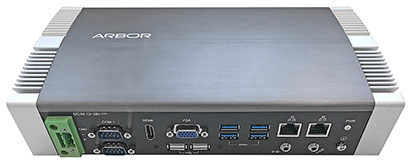
Removing the bottom plate reveals a roughly 6 x 4.75 inch PC-style motherboard with all the usual expansion slots and I/O connectors in addition to a full complement of edge mount connectors. A full-size mPCIe accommodates an mSATA solid state disk module (a 16GB MemoRight MS 500 in our review unit). Underneath that slot sits another half-size mPCIe slot. 8GB of fast, efficient DDR4 RAM is pre-installed on, and there's also a 260-pin DDR4 SO-DIMM socket for up to 16GB more. The ARES-1970 is virtually all I/O. There are eight DB9 RS232 serial ports, six USB ports, as well as dual gigabit RJ45 jacks, audio, and VGA and HDMI for video.
The expanded ARES-1970-E configuration
There are situations where a single mPCIe slot just isn't enough for storage requirements. Or where digital I/O is needed, or additional RJ45 jacks. That's where the ARES-1970-E comes in. It consists of two ARES-1970 housings mated together. That means dual heat spreaders and an internal configuration with all I/O, plus two 2-1/2-inch removable drive bays mounted on the front side. Those can be used in RAID 0 (striping for extra performance) or RAID 1 (mirroring for redundancy). Note that the Core i3 processor option does not support RAID.
The extra four RJ45 jacks are of the PoE (Power over Ethernet) variety. That comes in handy for surveillance and — especially — machine vision applications. PoE allows longer cable lengths to connect to devices than USB, and the 802.3af PoE standard provides up to 15.4 watts to each device.
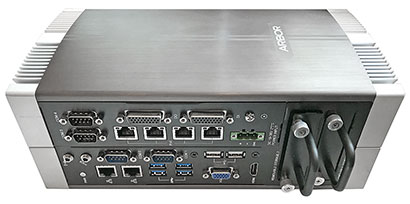
The image below to the right shows how two heat spreader housing modules are combined to create the ARES-1970-E version. 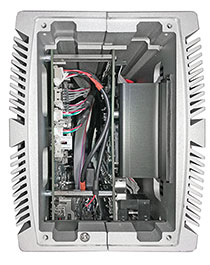 This increases size to 10.71 x 5.55 x 4.41 inches, and weight from 3.7 to 8.2 pounds. It also means the unit can be used standing up or sitting on its side (in addition to, of course, wall-mount or DIN-rail mount). This increases size to 10.71 x 5.55 x 4.41 inches, and weight from 3.7 to 8.2 pounds. It also means the unit can be used standing up or sitting on its side (in addition to, of course, wall-mount or DIN-rail mount).
Unlike the basic ARES-1970, the ARES-1970-E version uses a "gold finger"-connected PCIe riser card for a stacked board configuration.
And note that the ARES-1970-E foregoes four of the eight serial ports of the base version, so it only has four serial ports that support RS422 (which uses a differential electrical signal as opposed to the RS232 unbalanced signal referenced to ground).
The ARES-1970-4P/4E configuration
Not available to us for testing yet was the third version of the ARES-1970 line, the ARES-1970-4P/4E. 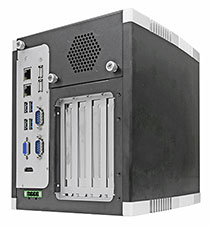 This version, also using two of the ARES-1970 Series heat sink/spreaders, but here they have different dimensions and are not directly mated to each other but serve as end caps of a roughly 8 x 8 x 8 inch cube. What's the extra space used for? That'd be either four PCI or four PCIe expansion boards. This version, also using two of the ARES-1970 Series heat sink/spreaders, but here they have different dimensions and are not directly mated to each other but serve as end caps of a roughly 8 x 8 x 8 inch cube. What's the extra space used for? That'd be either four PCI or four PCIe expansion boards.
PCI, which stands for Peripheral Component Interconnect, has been around for over two decades. PCI cards come in various configurations, heights and sizes. From the specs, we assume the ARES-1970-4P version can accommodate up to four half-length (6.9-inch) full-height (4.2-inch) cards.
PCIe (Peripheral Component Interconnect Express) is a faster, improved version of PCI, and the ARES-1970-4E can be equipped with up to four X1 single lane cards.
The table below shows the features and capabilities of the three versions of the ARES-1970 line, with darker green shading indicating main differences.
|
ARBOR
|
ARES-1970
|
ARES-1970-E
|
ARES-1970-4P/4E
|
|
CPU
|
Intel Skylake
|
Intel Skylake
|
Intel Skylake
|
|
Size (mm)
|
265 x 141 x 62
|
272 x 141 x 112
|
192 x 200 x 220
|
|
Video
|
1 x VGA, 1 x HDMI 1.4
|
1 x VGA, 1 x HDMI 1.4
|
1 x VGA, 1 x HDMI 1.4
|
|
LAN
|
2 x Gbe RJ45
|
2 x Gbe RJ45
|
2 x Gbe RJ45
|
|
PoE LAN
|
none
|
4 x PoE Gbe RJ45
|
none
|
|
DIO
|
none
|
16 x DI and 16 x DO
|
none
|
|
USB 2.0
|
4 x USB 2.0
|
4 x USB 2.0
|
6 x USB 2.0
|
|
USB 3.0
|
4 x USB 3.0
|
4 x USB 3.0
|
4 x USB 3.0
|
|
RS232/422/485
|
4 x RS232/422/485
|
4 x RS232/422/485
|
2 x RS232/422/485
|
|
RS232/422
|
4 x RS232/422
|
none
|
none
|
|
2.5" Drive Bay
|
None
|
2 x 2.5" Bay
|
2 x 2.5" Bay
|
|
PCI slots
|
None
|
None
|
4 x PCI or 4 x PCIe X1
|
|
RAID 0/1 support
|
no
|
yes
|
yes
|
|
Power
|
12 ~ 28VDC
|
19 ~ 36VDC
|
12 ~ 28VDC
|
Worth mentioning is the excellent quality of the manuals that come with each version. Each is around 90 pages and explains, describes and illustrates every aspect of the hardware and BIOS firmware.
Intel Skylake powered
Unlike general purpose PCs where more performance is always better than less, embedded systems are usually designed to handle well-defined, predictable workloads. Equipping such systems with more power than they need would be a waste. Industrial controllers, however, may see a wide range of demanding deployments, requiring both expandability and higher performance. 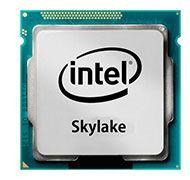 As a result, ARBOR decided to design the ARES-1970 line for use with the same high-performance Intel CPUs usually found in high-end rugged mobile computers. As a result, ARBOR decided to design the ARES-1970 line for use with the same high-performance Intel CPUs usually found in high-end rugged mobile computers.
Specifically, available is the choice of three 6th generation "Skylake" Intel Core processors, one each from the i3, i5, and i7 lines ("good," "better," "best"). Skylake is as of this writing (August 2017) no longer the latest generation of available Intel Core processors.
However, unlike the only slightly different "Kaby Lake" 7th generation of Intel Core processors, Skylake chips still give customers the choice of using operating systems prior to Windows 10.
Here is what is available for ARES-1970 Series controllers:
|
ARBOR ARES-1970 Series Processor Options
|
|
Available CPUs
|
Intel Core i7
|
Intel Core i5
|
Intel Core i3
|
|
Model
|
6600U
|
6300U
|
6100U
|
|
Cores/Threads
|
2/4
|
2/4
|
2/4
|
|
Base Clock Speed
|
2.60 GHz
|
2.40 GHz
|
2.30 GHz
|
|
Turbo Speed
|
3.40 GHz
|
3.00 GHz
|
No turbo
|
|
Thermal Design Power (TDP)
|
15 watts
|
15 watts
|
15 watts
|
|
Smart Cache
|
4MB
|
3MB
|
3MB
|
|
Integrated graphics
|
HD Graphics 520
|
HD Graphics 520
|
HD Graphics 520
|
|
Graphics base speed
|
300 MHz
|
300 MHz
|
300 MHz
|
|
Graphics max speed
|
1.05 GHz
|
1.00 GHz
|
1.00 GHz
|
|
RAID 0/1 support
|
Yes
|
Yes
|
No
|
|
Intel Stable Image Platform Program
|
Yes
|
Yes
|
No
|
|
Intel TSX-NI
|
Yes
|
Yes
|
No
|
|
Intel Trusted Execution
|
Yes
|
Yes
|
No
|
|
Intel vPro
|
Yes
|
Yes
|
No
|
For full specs pof the three chips, see their Intel Product Comparison Page. And here's a brief explanation of Intel technologies that some of the chips available for the ARES-1970 Series have or don't have:
- The extra security and manageability capabilities of vPro, especially, are required in many enterprise deployments (see Wiki Intel vPro).
- TSX-NI Transactional Synchronization Extensions New Instructions) helps make parallel operations more efficient via improved control of locks in software (see Wiki TSX),
- SIPP (Stable Image Platform Program) allows deployment of standardized, stable image PC platforms for at least 15 months (see Intel SIPP), and
- Trusted Execution technology provides security capabilities such as measured launch and protected execution, and may thus also be an enterprise requirement (see Wiki Trusted Execution Technology).
Skylake also offers Intel Authenticate, Intel's enhanced hardware security that strengthens identity protection.
To see what sort of performance our Core i5-6300U-based ARES-1970 and ARES-1970-E test units provide, we used Passmark Software's PerformanceTest 6.1 that runs about 30 tests covering CPU, 2D graphics, 3D graphics, memory, and disk and then computes scores for each category and an overall PassMark score:
|
ARBOR ARES-1970 Benchmark Performance
|
|
Performance benchmarks
|
ARES 1970
|
ARES 1970-E
|
|
CPU Mark
|
3,102.7
|
3,139.87
|
|
2D Graphics Mark
|
359.2
|
351.3
|
|
Memory Mark
|
848.0
|
875.2
|
|
Disk Mark
|
407.5
|
1,087.4
|
|
3D Graphics Mark
|
324.1
|
348.5
|
|
Overall PassMark
|
1,161.1
|
1,313.7
|
We didn't include any comparison units, but we still found some facts worth mentioning:
First, the performance level achievable with any of the three available processors are substantial. Most embedded systems perform at much lower levels. This is essentially "ready-for-anything" performance.
Second, note that the overall bottomline performance of our two test units differs more than one would expect, as they both had the same Core i5 processor. The reason is the significant performance difference between the two types of solid state disks used. The Intel SSD 320 Series 2-1/2-inch drive scored 2.5 times higher than the Memo Right MS 500 mPCIE card module. Neither are very fast, so significant performance increases can be had by using faster mass storage.
Application potential
ARBOR proudly points out that the ARES-1970-E won a "Taiwan Excellence Award 2017" in the High Flexibility Modularized Rugged Box PC category, and after examining two of those unit it's clear that they certainly deserved the recognition. The line convinces with its clever overall design approach, its space-saving modularity, and certainly with its performance.
The base ARES-1970 is small enough to fit almost anywhere and offers enough serial ports to communicate with up to eight legacy peripherals and systems. With its side expansion-facilitated digital I/O, dual 2.5-inch drive bays, and four Power-over-Ethernet 802.3af compatible LAN ports, the ARES-1970-E seems ideal for numerous surveillance and machine vision applications. And with its backplane-based PCI or PCIe expansion, the ARES-1970-4P/4e provides access to a vast wealth of interface cards and technologies in numerous industries.
All this combines to make the ARBOR ARES-1970 Series an exceptionally flexible and highly configurable fanless embedded controller platform that minimizes turnkey solution development cost, time, and effort. -- Conrad H. Blickenstorfer, August 2017
|



